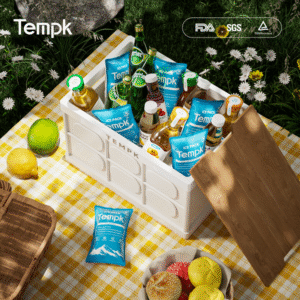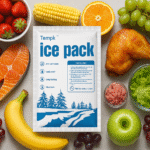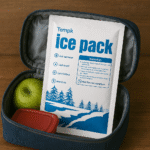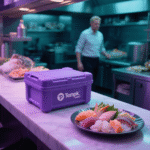Are Dry Ice Packs Food-Safe for Shipping Perishables?
Dry ice packs are a widely used solution in the food industry for shipping perishable items. Their ability to maintain ultra-low temperatures makes them ideal for keeping food frozen during transit. But are dry ice packs food-safe? This article answers that question by exploring dry ice’s properties, its use in food preservation, safety protocols, and best practices for handling.

¿Qué son las bolsas de hielo seco?, and Why Are They Important for Food Safety?
hielo seco, a solid form of carbon dioxide (Co₂), sublimates directly into gas at -78.5°C (-109.3°F), bypassing the liquid phase of normal ice. This unique property allows dry ice to maintain low temperatures for extended periods, making it an essential tool for preserving frozen food during shipping. Sin embargo, proper handling is necessary to ensure safety.
How Does Dry Ice Work to Preserve Food?
Dry ice is extremely effective in preventing food spoilage during transportation by maintaining frozen states, especially for sensitive products like ice cream, carnes, y mariscos. It does this by keeping the temperature consistently below freezing, which prevents thawing and bacterial growth.
Are Dry Ice Packs Safe for Food?
Dry ice itself is no tóxico, but it poses risks due to its extreme cold. Direct contact with dry ice can cause frostbite or cold burns on food, leading to undesirable texture changes, quemadura del congelador, or even food damage. The key safety principle when using dry ice is to prevent direct food contact.
Best Practices for Using Dry Ice in Food Shipping
Here are some crucial guidelines for ensuring the safe use of dry ice for food applications:
-
Embalaje & Separation
Use insulated containers that prevent direct contact between dry ice and food. Ensure proper separation using refrigeradores de espuma, plástico de burbujas, o cardboard layers. -
La ventilación es clave
Always use packaging that allows the sublimated CO₂ gas escapar. Evite los contenedores herméticos, as they can cause pressure buildup, which could be hazardous. -
Manejo y almacenamiento
Siempre usa guantes criogénicos y safety goggles when handling dry ice. Store dry ice in well-ventilated spaces, away from heat or direct sunlight, to avoid dangerous buildup of CO₂ gas. -
Transportation and Compliance
Cuando envía, ensure vehicles are well-ventilated to prevent CO₂ accumulation. Always follow the directrices regulatorias for shipping hazardous materials and include “Contains Dry Ice” labeling as per regulations.
What Alternatives to Dry Ice Are Available for Safe Food Shipping?
While dry ice is effective for longer shipments, paquetes de gel y materiales de cambio de fase (PCM) are becoming more popular for envíos a corto plazo. These alternatives are safer and easier to handle as they don’t involve hazardous CO₂ gas.
| Agente refrigerante | Paquetes de hielo seco | Paquetes de gel | PCM |
|---|---|---|---|
| Control de temperatura | Extremadamente frío (-78.5°C) | Frío moderado (0° C a -20 ° C) | Customizable for specific ranges |
| Seguridad | Requiere un manejo especial; hazardous | No tóxico, aficionado a la comida | No tóxico, safe for direct contact |
| Duración | De larga duración (12-48 horas) | Duración más corta | Longer than gel packs, but varies |
| Impacto ambiental | Emisiones de co₂ | Biodegradable or recyclable | Biodegradable, ecológico |
Soluciones híbridas: Combining Dry Ice and Gel Packs
For shipments that require both congelación profunda y refrigeración, combining dry ice with gel packs can create a stable temperature environment. This hybrid solution works especially well for longer transit times, ensuring that sensitive food products stay congelado o refrigerado without risk of rapid thawing.
Common Mistakes and How to Avoid Them
-
Nunca almacene hielo seco en recipientes herméticos – CO₂ gas needs to escape to avoid dangerous pressure buildup.
-
Evite el contacto directo con los alimentos – Use insulation layers between the dry ice and food to prevent freezer burn.
-
Usar equipo de protección – Never handle dry ice with bare hands. Usar guantes aislados y safety goggles.
How to Safely Ship Different Types of Food
Frozen Seafood (24-36 horas):
Combinar hielo seco con paquetes de gel. Place seafood in an airtight plastic wrap, then surround it with gel packs and a layer of dry ice (separado por cartón).
Kits de comida (24 horas):
Usar paquetes de gel and an insulated liner to maintain the appropriate refrigeration temperature. Place one gel pack above and one below the food for balanced temperature control.
Vacunas (48-72 horas):
Use certified medical shipping containers with built-in ventilation, combining hielo seco con PCM to maintain a steady temperature.
2025 Trends in Cold Chain and Dry Ice Usage
El cold chain packaging market is projected to grow from USD 29.1 mil millones en 2025 a USD 50.5 mil millones por 2035. Key trends shaping the future of dry ice use in food shipping include:
-
Materiales sostenibles – Use of biodegradable y reciclable gel packs and insulation materials.
-
IoT & Monitoreo en tiempo real – Integration of sensores y Etiquetas RFID to monitor food temperature throughout the shipping process.
-
Smarter Packaging Solutions – Advancements in materiales de cambio de fase for better temperature control.
Conclusión & Recomendaciones
Dry ice packs are a safe and effective solution for shipping frozen food, provided that direct contact with food is avoided, y safety guidelines are followed. Siempre usa contenedores aislados, asegurar ventilación, y wear protective gear to prevent injuries. Para envíos más cortos, paquetes de gel y materiales de cambio de fase are viable alternatives.
Toma medidas hoy:
-
Assess your shipment needs: Choose dry ice for frozen items, gel packs for refrigerated goods.
-
Asegurar un embalaje adecuado: Use insulated boxes and separate dry ice from food.
-
Educate your team and customers: Provide handling instructions and safety warnings.
Acerca de Tempk
Tempk is a trusted provider of Soluciones de hielo seco y embalaje de cadena de frío for the food industry. We specialize in creating seguro, eficiente, y ecológico shipping solutions to ensure that your products stay fresh from point A to point B. Contact us today for more details on how we can help your business maintain the integrity of your cold chain.























